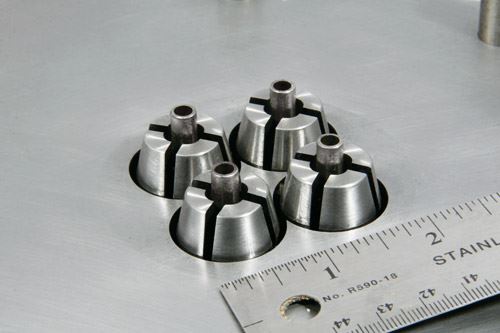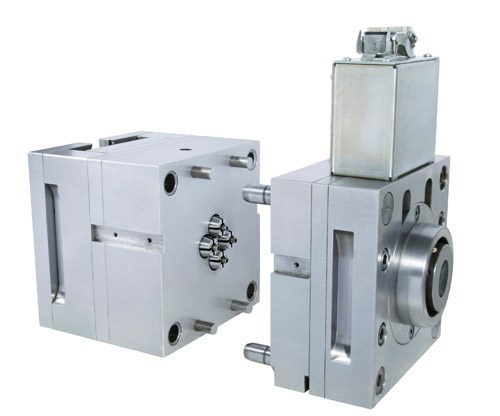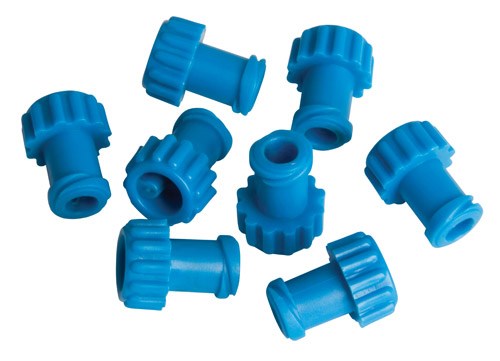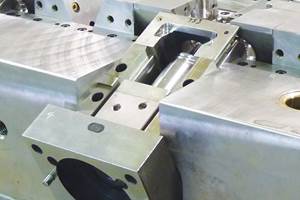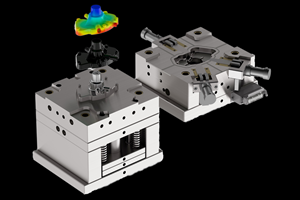Run Clean, Run Efficient
Better undercut release for small medical parts.
Medical parts have different requirements than other molded articles, and as a result tooling engineers over the years have pioneered new mold materials, coatings and mold maintenance practices.
For example, a typical luer fitting is used for making a secure, leak-proof attachment with tubing connections in medical devices and other instruments. These small connectors frequently have undercuts, and when they do, there are considerable cost and risk implications for the molding of these parts. However, practices are evolving and tooling engineers have begun using a single, expanding cavity component as an alternative to slide mold traditions of the past.
Containing the part’s undercuts within an expandable cavity results in a mold that is smaller and simpler, with less moving parts. Design time is reduced and mold construction hours are less. With a smaller mold, lower hourly press rates result, and when a mold is less complex, it is easier and less costly to properly maintain.
Slide molds require lubrication, introducing opportunities for part contamination, while an expandable cavity requires no such grease. And rather than nesting round parts within long slides, more conformal cooling and a more balanced runner system can be achieved by using a component that forms the part concentrically.
Expandable cavities are constructed in an expanded position, meaning that during molding they are pulled back against a striker ring and collapsed inward. For ejection, the component is staged forward, which allows the segments of the expandable cavity to expand outward. This releases the undercut and the part is then ready for ejection. They are commonly staged forward during mold open to enable the fastest possible cycle time.
Report from the Field: Expandable cavities can sometimes be a project-saving solution, as it was for Cape Fear Mold & Tool Co., Inc. Mike Rockwell explains that his customer required two hot runner molds with undercuts to be built. “One of the molds was fairly simple except for some undercuts, but the second mold turned into a bear,” he says. “It had a long, thin core running thru the center, undercuts on the inside that required the expandable cavities, undercuts around the outside that required slides, and, to top it all off, it had a 0.016” vent hole in the face.”
The complexity of the second mold wasn’t the only criterion that had to be met, but there were also space considerations and a tight delivery time to think about.
“The expandable cavity system was really the only option,” Mike notes. “We had worked with several collapsible cores in the past and have always been quite happy with those, so I was confident the expandable cavity system would work just as well. The beauty of the expandable cavities is that there is really no way to crash the mold.”
The project was a success, and Mike said his customer was very satisfied. “My customer couldn’t have been happier with the mold,” he says. “They were actually surprised when we completed the project without any design change requests.”
In medical molding, the stakes are high. The ramifications that are on every tooling engineer’s mind can cause one to default into building the next tool much like the last tool. However, beyond the cost savings of a smaller and more straightforward mold build, containing the part’s undercut details within a single component ensures part accuracy, optimal cooling, greaseless molding, and dramatically simplified mold maintenance. These advantages reduce risk and liability over the course of a medical mold’s lifetime.
Related Content
Forces and Calculations Are Key to Sizing Core Pull Hydraulic Cylinders
To select the correct cylinder, consider both set and pull stroke positions and then calculate forces.
Read MoreHow to Solve Core Pull Flash and Part Issues
Many mold problems can be solved by simply providing enough preload force on the core to prevent movement.
Read MoreWhat Really Happens Inside a Micro Mold Cavity
Micromolding offers new business opportunities, but moldmakers must tackle unique production and design challenges. An innovative direct-gating process is one solution.
Read MoreTips for Tackling Mold Design, Machining, Cutting Tool and Wear Challenges
Tips for tasks ranging from reducing risk in part design and taking advantage of five-axis machining to refining cutting tool performance and reducing wear with guiding and centering systems.
Read MoreRead Next
How to Use Continuing Education to Remain Competitive in Moldmaking
Continued training helps moldmakers make tooling decisions and properly use the latest cutting tool to efficiently machine high-quality molds.
Read MoreYour Guide to Smarter, Faster Mold Design
Dive into expert-curated content delivering proven solutions for mold optimization, manufacturability and precision performance.
Read MoreHow to Use Strategic Planning Tools, Data to Manage the Human Side of Business
Q&A with Marion Wells, MMT EAB member and founder of Human Asset Management.
Read More
